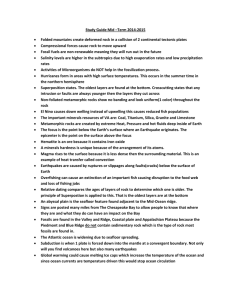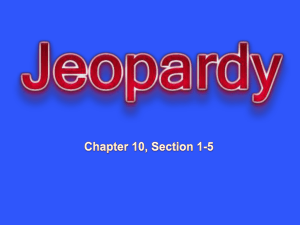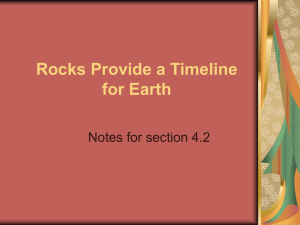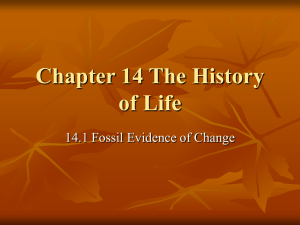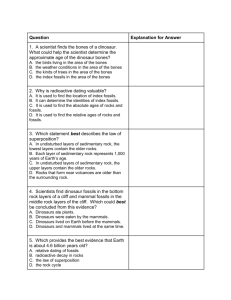Biostratigraphy
advertisement
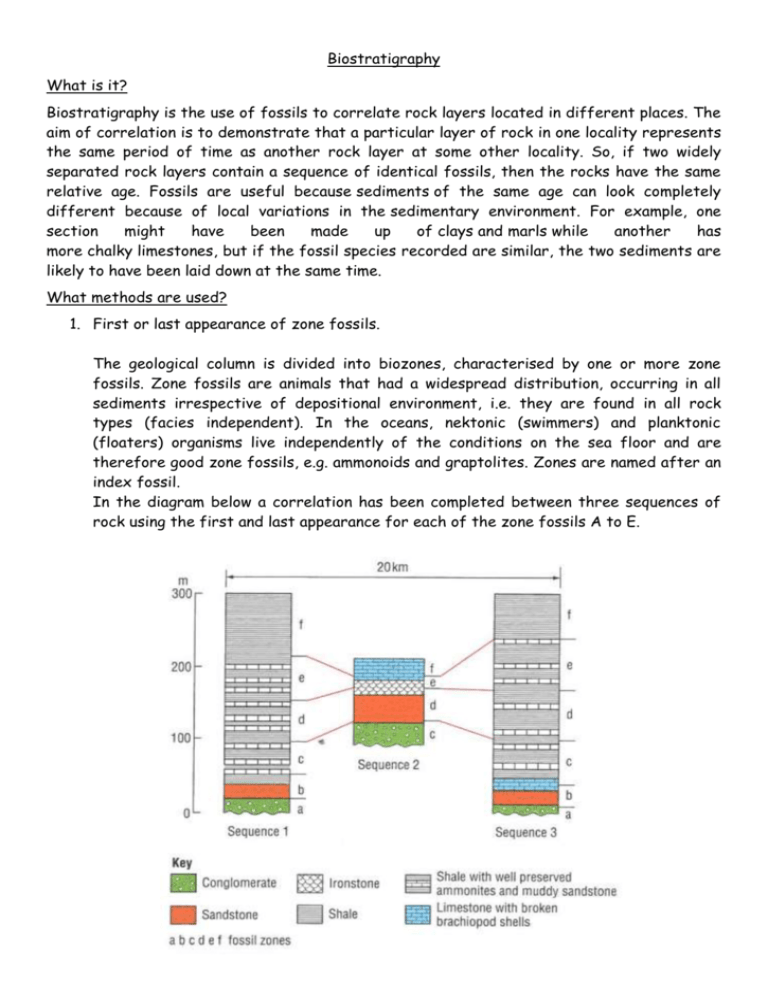
Biostratigraphy What is it? Biostratigraphy is the use of fossils to correlate rock layers located in different places. The aim of correlation is to demonstrate that a particular layer of rock in one locality represents the same period of time as another rock layer at some other locality. So, if two widely separated rock layers contain a sequence of identical fossils, then the rocks have the same relative age. Fossils are useful because sediments of the same age can look completely different because of local variations in the sedimentary environment. For example, one section might have been made up of clays and marls while another has more chalky limestones, but if the fossil species recorded are similar, the two sediments are likely to have been laid down at the same time. What methods are used? 1. First or last appearance of zone fossils. The geological column is divided into biozones, characterised by one or more zone fossils. Zone fossils are animals that had a widespread distribution, occurring in all sediments irrespective of depositional environment, i.e. they are found in all rock types (facies independent). In the oceans, nektonic (swimmers) and planktonic (floaters) organisms live independently of the conditions on the sea floor and are therefore good zone fossils, e.g. ammonoids and graptolites. Zones are named after an index fossil. In the diagram below a correlation has been completed between three sequences of rock using the first and last appearance for each of the zone fossils A to E. 2. Range of zone fossils The range of zone fossil can also be very helpful when used with other fossils. Some fossils, such as B in the diagram below, have a short range, others such as A have a longer range time, but where two or more fossil ranges overlap, for example, C and B, a particular biozone can be precisely determined. The shorter the time range, the better the zone fossil. 3. Fossil assemblages A fossil assemblage is when a number of different fossils are found in one bed. On the diagram below, bed 3 can be defined by having the assemblage of fossils A C D E. What are the problems? Many fossil, especially benthonic (sea-floor dwellers) invertebrates, are restricted to particular environments, for example lime-mud sea floor, reef and sandy sea floor, so are found in just a few rock types. Some kinds of fossils are very long-ranged. Their rates of evolutionary change were very slow, so are no use for establishing biozones. Good zone fossils such as graptolites are delicate and are only preserved in low energy environments, being destroyed in more turbulent conditions. Derived fossils confuse the true sequence of beds. They will give an age far older than the rock they have ended up in after erosion and redeposition. Not all sedimentary rocks contain fossils. In particular, rocks laid down in glacial, fluvial and desert environments on land are unlikely to have any fossils. Lithostratigraphy What is it? This is the study of the physical properties of rock layers, which include grain size, grain roundness, colour, chemical composition etc. As rock layers have distinctive physical properties the sequence of these layers can be correlated from place to place. These sequences of different rocks are used to establish the changing geological conditions or geological history of the area through time. The description, definition and naming of the rock units is termed lithostratigraphy (rock stratigraphy). What methods are used? 1. You could correlate using a sequence of beds. In the diagram below, you could use the sequences in the diagram then you would correlate the sandstones overlying the conglomerate for all three boreholes. 2. Looking at the thicknesses of beds can also be used to correlate between areas. It is a bit like recognising a barcode; it does not matter if the whole thing is large or small, it is the sequence of thin and thick bars that gives you the information. Such a correlation might work for identifying where you are in a coalfield. This diagram shows the coal seams in three different locations (from borehole data) can be correlated by recognising the pattern of bed thicknesses. In these, three cores, corresponding seams are found at different depths and are different thicknesses. It is the pattern of relative thickness that allows correlation. 3. Sometimes a marker horizon may be used to correlate layers of rock between two areas. A marker horizon is a bed so easily distinguished that you instantly know where you are in the sequence. These are always unusual, such as an oxidised red bed in a sequence of dark rocks. The composition of beds may also be distinctive with a rare mineral present in a bed, for example, the Cretaceous-Tertiary boundary of rocks are correlated on the presence of iridium. What are the problems? 1. Without fossil evidence, lithostratigraphic correlation is very difficult. Just because two beds of rock have the same physical properties does not always mean they are the same age. 2. Lateral variation – where sediments change horizontally. When there is a high level of lateral variation the lithostratigraphic correlation is unlikely to match the biostratigraphy or chronostratigraphy. a. Sedimentary deposits change in thickness laterally, for example, closer to the source of the sediment beds may be thicker, further away they may be thinner. This happens in deposits formed by turbidity currents in deep sea areas. b. In a fluvial environment, point bar sands are being deposited at the same time as flood plain clays. In a shallow marine, environment, there will be sandstones being laid down close to the beach, while at the same time clays are being deposited off-shore in the low-energy environments. c. Similarly, deltaic sediments have different sediments forming in the delta top, front and offshore areas at the same time. 3. Diachronous beds – where one sediment type is laid down at different times. The result of different sediments being laid down at the same time is diachronous beds which cut “across time”. A good example is where a delta is building out into the sea. Over the years, a continuous layer of sands is left behind. These sands get younger from land to sea – they are definitely NOT the same age. The same is true for the other rock types in a delta cycle. Chronostratigraphy What is it? Chronostratigraphy is used to assign an actual age to the rocks (i.e. absolute dating). This branch of stratigraphy came into being much later than lithostratigraphy and biostratigraphy, due to the high level of technology needed to date rocks. Using chronostratigraphy in conjunction with lithostratigraphy and biostratigraphy, the world’s rocks can quite easily be dated and correlated. What methods are used? 1. Using varves from glacial lakes. One of the oldest methods employed for absolute age determination, varve analysis, was developed by Swedish scientists in the early 20th century. A varve is a sedimentary bed, or sequence of beds, deposited in a body of still water within a year's time. Counting and correlation of varves have been used to measure the ages of Pleistocene glacial deposits. By dividing the rate of sedimentation in terms of units per year by the number of units deposited following a geologic event, geologists can establish the age of the event in years. In the summer, glacial ice melts faster and the increased flows carry down silts into the lake to make a thin pale layer. During the winter, there is no meltwater and the lake itself may freeze over. The result is a very low energy deposition of clay particles and organic matter that grows under the ice to produce a thin dark layer. One year is recorded as a pair of layers on the lake bed. This means that geologists can count layers to find out how many years are represented in the sequence. The correlation is provided by thicker layers resulting from hotter summers, the pattern of thick and thin bands being the same for all lakes in the same area. 2. Potassium-argon dating Potassium-argon (K-Ar) dating is the most widely used method of radiometric dating. Potassium is a component in many common minerals and can be used to determine the age of igneous, metamorphic and sedimentary rocks. Naturally occurring radioactive isotopes in rocks are unstable and break down (decay) at a statistically constant rate. This rate of decay can be measured and expressed as the half-life of the isotope – the time taken for half of the unstable parent atoms to break down to stable daughter atoms. If the relative amounts of parent and daughter atoms in a rock sample can be measured, then we know how many half-lives have passed since the parent was created. For example, if the ratio of parent to daughter is 50:50, then one half-life has passed since the radioactive atom was created. If it the ratio is 25:75, then two half-lives have passed. The relative amount of parent and daughter atoms is measured using a mass spectrometer. The radioactive isotope 40 K decays to decays to produce two isotopes. 40 40 Ar and 40 Ca with a half-life of 1260 Ma. 40 K Calcium is the beta particle formed but this cannot be used for dating as it is indistinguishable from the calcium commonly occurring in many rocks. Fortunately, 11% decays to form the stable alpha particle 40 Ar. This is a gas, which is not formed in any other way. The best rock to use for this kind of dating is tuff, which is a rock resulting from pyroclastic deposition. When a violent eruption occurs, ash is blasted tens of kilometres into the atmosphere and is laid down over enormous areas at exactly the same time – geologically instantaneously. 3. Rubidium-strontium dating Rubidium has several isotopes, 50000 Ma. It decays to form 87 Rb being the most useful one. It has a very long half-life; 87 Strontium as the daughter isotope. This is a solid and therefore unlikely to be lost from the rock. Rb-Sr dating is thus more useful for metamorphic rocks than K-Ar. What are the problems? 1. Scarcity of radioactive minerals Radioactive isotopes are only found in small quantities in some rock-forming minerals. As a result, only a few rocks can be dated radiometrically. To obtain enough material for an accurate analysis is difficult. It may involve crushing the rock and picking out the required minerals such as zircon or muscovite from the rock. 2. Problems with dating sedimentary rocks Obtaining accurate dates from sedimentary rocks is very difficult because weathering and erosion tend to break up the closed system that is essential for a reliable date. Problems are due to the loss of gases where weathering has allowed the argon to escape, resulting in a date that is older than it should be. Especially in sedimentary rocks, where glauconite is the only mineral with 40 K, initial amounts of the isotope can be difficult to determine. Sedimentary rocks are made up of fragments of older rocks. The clasts could have a range of ages all older than the rock being dated. Radiometric dates can therefore be very misleading, giving much older dates. 3. Problems with dating metamorphic rocks Metamorphic rocks also cause problems. Different minerals become closed systems at different temperatures. Parent or daughter atoms can be lost or gained during heating events. K-Ar has closure temperatures between 150 and 550°C, depending on the mineral used. During a series of metamorphic events the radiometric clock will have been reset in some minerals and not in others – a variety of conflicting dates is possible. 4. Problems with dating igneous rocks There are even problems associated with dating igneous rocks, as large-scale intrusions may take tens of millions of years to cool – different parts reach the closure temperature at different times. The most reliable igneous rock dates are therefore minor intrusions and extrusions that cool rapidly. The stable daughter atoms produced in K-Ar dating is argon which is a gas and can easily escape from the mineral lattice, especially when heated. Loss of this daughter product leads to an underestimate of the rock age.

